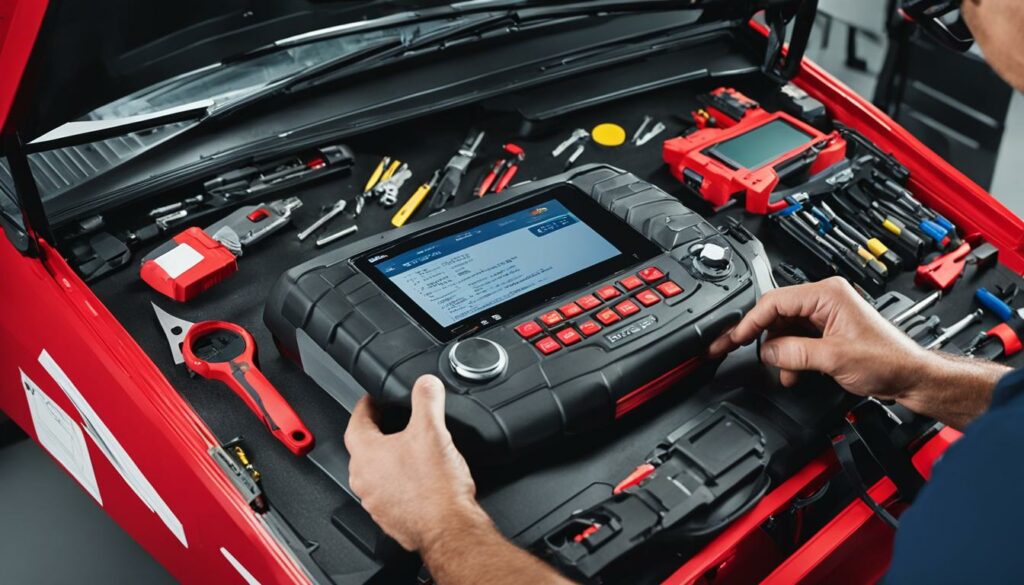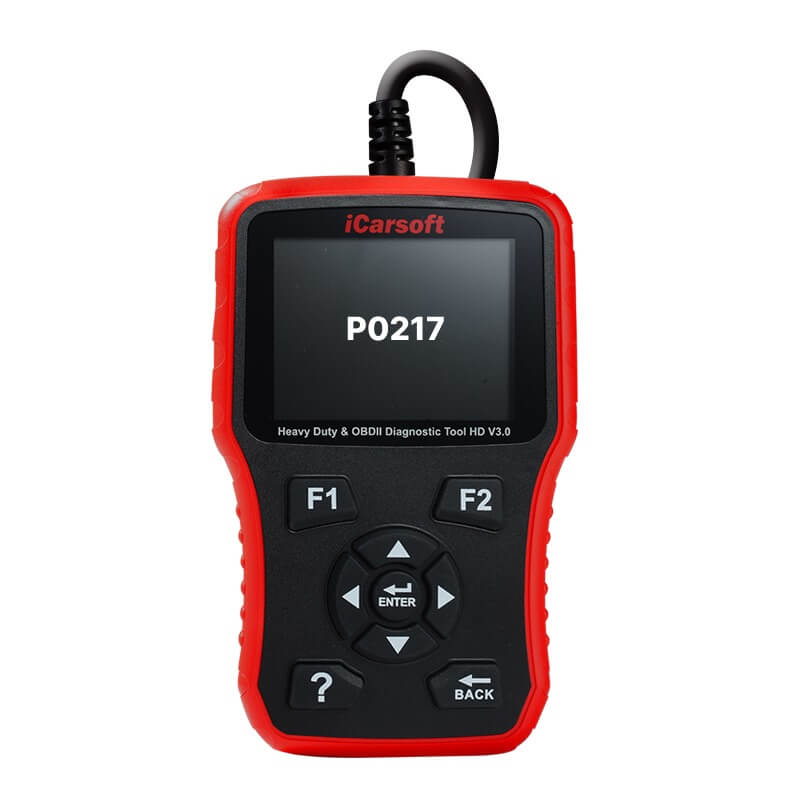P0217 – Over Temperature Condition
POSTED IN pcodes
Welcome to our informative guide on the P0217 code – Over Temperature Condition. In this article, we will explore the causes, symptoms, diagnosis, and repair of this engine overheat issue. If you’ve noticed your vehicle temperature gauge running high or the check engine light illuminating due to engine temperature being too high, it’s important to troubleshoot and resolve the over temperature condition promptly.
Key Takeaways:
- The P0217 code is triggered when the engine is or was overheating, indicating a potentially serious issue.
- Common causes of the P0217 code include cooling system leaks, a faulty coolant temperature sensor, damaged wiring, a faulty powertrain control module, and more.
- Symptoms of the P0217 code may include reduced engine power, engine shut off, steam or smoke emission, loud boiling sounds, and coolant explosion.
- Diagnosing the P0217 code involves checking coolant level, inspecting the cooling system, running a pressure test, and checking the functionality of the cooling fans.
- Repairing the P0217 code may require replacing coolant leak parts, the coolant temperature sensor, powertrain control module, repairing or replacing wiring, and running a high pressure coolant flush.
Causes of the P0217 code
The P0217 code can be triggered by several factors that affect the cooling system of your vehicle. Some of the common causes of the P0217 code include:
- Cooling system leaks: Leaks in components such as the radiator, thermostat housing, radiator hoses, heater hoses, water pump, head gasket, or the engine itself can lead to the P0217 code.
- Faulty coolant temperature sensor: A malfunctioning coolant temperature sensor can send incorrect signals to the powertrain control module, causing it to register a high temperature and trigger the P0217 code.
- Damage to wiring: Damaged wiring associated with the coolant temperature sensor can disrupt the signal transmission and result in the P0217 code.
- Faulty powertrain control module: If the powertrain control module responsible for regulating various engine functions is faulty, it may incorrectly interpret the coolant temperature data and trigger the P0217 code.
- Inoperative fan clutch or electric cooling fan: When the fan clutch or electric cooling fan fails to operate effectively, it can lead to inadequate cooling of the engine, causing it to overheat and trigger the P0217 code.
- Restriction in the radiator: If there is a restriction in the radiator or other parts of the cooling system, it can impede proper coolant flow and result in engine overheating, triggering the P0217 code.
- Stuck thermostat: A stuck thermostat that fails to open properly can prevent the coolant from flowing through the engine and radiator, leading to overheating issues and the P0217 code.
Identifying and resolving these underlying causes is crucial to effectively resolve the P0217 code and prevent further damage to your engine.
Symptoms of the P0217 Code
When your vehicle experiences the P0217 code, it is often accompanied by several noticeable symptoms. These symptoms serve as critical indicators of the underlying issue. It’s important to be aware of these symptoms and address them promptly to prevent severe engine damage. Here are the key symptoms associated with the P0217 code:
1. Reduced Engine Power
One common symptom of the P0217 code is a noticeable reduction in engine power. In vehicles equipped with fail-safe cooling systems, you may receive a message indicating the reduced engine power. This serves as a safety measure to prevent further overheating and potential engine damage.
Buy tested tuning file for Adblue / EGR / DPF / Adblue off now!
2. Engine Shut Off
In order to prevent severe overheating, the engine may shut off automatically when the P0217 code is triggered. This protective measure ensures that the engine does not reach dangerous temperature levels, safeguarding against potential damage and ensuring your safety.
3. Steam or Smoke Emission
Another symptom of the P0217 code is the emission of steam or smoke from the engine compartment. This can be visually observed and indicates that the engine is experiencing excessive heat. It is crucial to address this symptom promptly as prolonged overheating can lead to severe engine damage.
4. Loud Boiling Sounds
If you hear loud boiling sounds coming from the engine bay, it is a significant symptom of the P0217 code. These sounds indicate that the engine coolant is reaching boiling point due to excessive heat. Ignoring this symptom can lead to catastrophic engine failure, making it imperative to take action promptly.
5. Coolant Explosion
In extreme cases, the P0217 code can cause coolant explosion from any part of the cooling system if it becomes over pressurized. This can result in coolant leaking or spraying out, posing a risk of injury and further engine damage. It is crucial to address this symptom immediately to prevent hazardous situations.
Being aware of these symptoms and promptly addressing them can help prevent further engine damage and ensure the safety and reliability of your vehicle. In the next section, we will explore the process of diagnosing the P0217 code.
Diagnosing the P0217 Code
When dealing with the P0217 code, it is crucial to diagnose the issue accurately to prevent further damage to your vehicle. Follow these steps to diagnose and troubleshoot the P0217 code:
- Start by checking the coolant level in your vehicle. Low coolant levels can lead to overheating and trigger the P0217 code.
- Inspect the cooling system for any damages or leaks. Look for signs of coolant leakage around components such as the radiator, thermostat housing, hoses, water pump, and head gasket.
- If no obvious issues are found, perform a cooling system pressure test. This test will help detect any hidden leaks that might be causing the code.
- Check the operation of the electric cooling fans or fan clutch. Faulty fans or fan clutches can prevent proper cooling system function and trigger the P0217 code. Replace any faulty components as necessary.
- Use an infrared thermometer to identify hot spots in the cooling system. Hot spots can indicate potential restrictions that are causing overheating. Address any restrictions by flushing the system or replacing damaged components.
- Verify the functionality of the coolant temperature sensor. A faulty sensor can provide incorrect temperature readings and trigger the code. Check for any wiring issues associated with the sensor as well.
- If all the above steps do not resolve the issue, it may be necessary to inspect the powertrain control module (PCM) for any faults. The PCM controls various functions of the engine, including the cooling system. Replace the PCM if necessary.
Pro Tip: It is recommended to consult a professional mechanic or a diagnostic tool for accurate diagnosis of the P0217 code. They have the expertise and equipment to identify and resolve the underlying issues effectively.

By following these steps and addressing the possible causes of the P0217 code, you can diagnose the issue and take appropriate measures to resolve it. Remember, prompt diagnosis and repair are essential to prevent engine damage and ensure the proper functioning of your vehicle’s cooling system.
Repairing the P0217 Code
Once the underlying issues that trigger the P0217 code have been identified, it’s time to proceed with the necessary repairs. The following components may need to be replaced to rectify the problem:
“Replacing coolant leak parts is crucial in resolving the P0217 code.”
- Radiator
- Thermostat housing
- Radiator hoses
- Heater hoses
- Water pump
- Head gasket
- Thermostat
- Heater core
Additionally, the coolant temperature sensor and the powertrain control module may require replacement to ensure accurate temperature readings and proper communication between the various systems.
If there are any issues with the wiring associated with the coolant temperature sensor or the electric cooling fan, repairing or replacing the wiring becomes necessary to restore proper functionality.
In some cases, running a high pressure coolant flush on the vehicle can help remove any accumulated debris or contaminants that may be hindering the cooling system’s performance.
By addressing these repairs and ensuring all components are in optimal condition, you can effectively resolve the P0217 code and prevent further overheating issues.

Common Repair Actions for the P0217 Code
| Repair Action | Component |
|---|---|
| Replacement | Radiator |
| Replacement | Thermostat housing |
| Replacement | Radiator hoses |
| Replacement | Heater hoses |
| Replacement | Water pump |
| Replacement | Head gasket |
| Replacement | Thermostat |
| Replacement | Heater core |
| Replacement | Coolant temperature sensor |
| Replacement | Powertrain control module |
| Repair/Replacement | Wiring for coolant temperature sensor and electric cooling fan |
Conclusion
The P0217 code is a severe issue that should not be ignored. Ignoring this code can lead to engine failure and costly repairs. It is critical to diagnose and repair the code promptly to prevent further damage to the engine. Regular vehicle maintenance, such as replacing the coolant at recommended intervals, can help prevent overheating issues.
If professional assistance is unavailable, an alternative solution is to upload the Engine Control Unit (ECU) file to a portal for permanent removal of the P0217 code. Taking prompt action and addressing the P0217 code can ensure a cooler and safer ride.
FAQ
What does the P0217 code mean?
The P0217 code is triggered when the engine is or was overheating, indicating a potentially serious issue. It is stored in the powertrain control module when the engine coolant temperature exceeds the manufacturer’s specified limit.
What are the common causes of the P0217 code?
Common causes of the P0217 code include cooling system leaks, faulty coolant temperature sensor, damaged wiring, faulty powertrain control module, inoperative fan clutch or electric cooling fan, restriction in the radiator, and a thermostat that is stuck closed.
What are the symptoms of the P0217 code?
Symptoms of the P0217 code may include reduced engine power, engine shut off to prevent severe overheating, steam or smoke emitted from the engine compartment, loud boiling sounds from the engine bay, and coolant explosion.
How is the P0217 code diagnosed?
Diagnosing the P0217 code involves checking the coolant level, inspecting the cooling system for leaks, running a cooling system pressure test, checking the operation of the electric cooling fans or fan clutch, using an infrared thermometer to identify hot spots in the cooling system, and checking the coolant temperature sensor and powertrain control module for faults.
How is the P0217 code repaired?
Repairing the P0217 code involves addressing the underlying issues that trigger the code. This may include replacing coolant leak parts, such as the radiator and thermostat housing, replacing the coolant temperature sensor and powertrain control module, repairing or replacing wiring, and running a high pressure coolant flush.
Why is it important to address the P0217 code?
Ignoring the P0217 code can lead to engine failure and costly repairs. Prompt diagnosis and repair are crucial to prevent further damage to the engine. Regular vehicle maintenance, such as replacing the coolant at recommended intervals, can help prevent overheating issues.


